Jane Has a Request
She would like a good book on optical illusions, possibly with instructions for how to draw some of the trickier ones. Escher staircases, that kind of thing. Geometric patterns that mess with your head. Got any favorites?
She would like a good book on optical illusions, possibly with instructions for how to draw some of the trickier ones. Escher staircases, that kind of thing. Geometric patterns that mess with your head. Got any favorites?
Disgruntled 3-year-old reporting on her big brother: “Mommy, he keeps telling me to knock it off! The ploblem is, I don’t want to knock it off.”
(Poetry Friday visitors, Miss Dickinson awaits you at the bottom of the post.)
I mentioned I’ve become hooked on beekeeping blogs ever since reading Fruitless Fall. Here are a few of my favorites:
Hive Mind Bee Blog. A backyard beekeeper in Washington. I especially enjoyed his account of a swarm in his neighborhood:
When they’re flying in the air, there’s nothing you can do but watch, but when the queen lands, the rest of the swarm will land around her in a huge, sedate clump that you can put into a bucket or a box and put back into a hive. Julie made a quick call to Dawn of the Puget Sound Beekeeper’s Association, got some info on how to proceed, and we were back in business. I threw on some overalls and my bee shirt, grabbed a bucket and a spatula, and I’s ready for action. First, though, I stopped off at the school across the street where kids and parents were doing landscaping and upkeep on the grounds and let them know that we had a science fair moment, if they were interested. A couple of the moms gathered up a dozen or so 5 – 10 yr olds and they all trooped over to see the bees.
Honey Run Apiaries. Great pictures, thoughtful discussion, wry observations.
I recently read an 1858 book ‘Phelps Bee-Keeper’s Chart‘. The book is obviously horribly out of date and out of print (though it is available on-line). Though it is interesting none-the-less for several reasons. While it does cover a lot about honey bees, much of it is for the purpose of promoting the authors patented ‘Ohio Combination Bee-Hive‘ saying that he expects it to ‘ supersede all others’. Sadly, while it apparently claimed honors at the Ohio and other state fairs, his book was published 6 years after Lorenzo Lorraine Langstroth’s book ‘The Hive and the Honey Bee’, which details the bee hive most of us use today in the US and in other parts of the world.
Fruitless Fall discussed the rise of the Langstroth hive, so that was a neat connection for us. Amusing tidbit at the bottom of that post:
The running joke is that if you ask 5 beekeepers in a room a question, you will receive 6 different answers. Apparently this is one of the oldest beekeeping jokes on record. Phelps wrote nearly 150 year ago that ‘there is scarcely any subject on which such a diversity of opinion exists, as on the form and size of bee-hives, and the general management of bees.’
Linda’s Bees might be my favorite beekeeping blog so far. She writes from Atlanta and posts the most incredible pictures, really informative shots that let you see the action inside a hive. Her hives have fun names like Bermuda and Mellona (the Roman goddess of bees). Excellent sidebar full of links we’re exploring as time permits.
We rented this NOVA film about bees: Tales from the Hive. The cinematography was fairly stunning. The corresponding website has video of the different bee dances and an interview with the filmmaker about how he managed the breathtaking closeup shots of bees in flight.
The next step was to find out how I could fly with the bees, because they are fast. I told myself, if I can’t fly with the bee, then the bee has to fly with me—that is, with the camera, directly in front of the lens. It was like the work at a clockmaker’s. We used a pair of tiny tweezers to form a wafer-thin wire. We then tied the bee up with this—very carefully, because we did not want to harm the bee, and we wanted to make sure it had the freedom to move its wings. A special kind of arrangement enabled us to fix the wire to the camera.
The film was made in 2000, before the beginning of bee colony collapse and I think possibly even before the massive varroa infestation that has crippled so many hives in recent years.
My dear daddy sent me some cool links:
How to make a house for mason bees
Pursuit of the perfect pollinator
(Thanks, Dad!)
Since today is Poetry Friday, let me leave you with a little Emily Dickinson.
The Bee
Like trains of cars on tracks of plush
I hear the level bee:
A jar across the flowers goes,
Their velvet masonry
Withstands until the sweet assault
Their chivalry consumes,
While she, victorious, tilts away
To vanquish other blooms.
Her feet are shod with gauze,
Her helmet is of gold;
Her breast, a single onyx
With chrysoprase, inlaid.
Her labor is a chant,
Her idleness a tune;
Oh, for a bee’s experience
Of clovers and of noon!
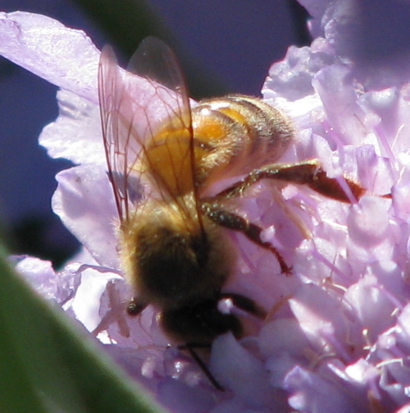

Best. Yes. Ever.
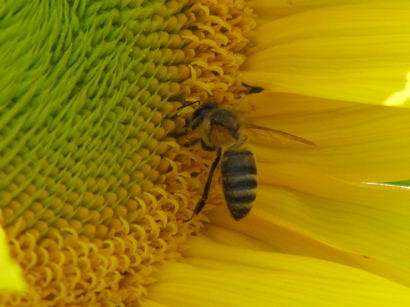
As you know, I’ve had bees on my mind for weeks. I keep talking about Fruitless Fall: The Collapse of the Honey Bee and the Coming Agricultural Crisis, the book about bee colony collapse written by my former grad-school classmate, Rowan Jacobsen.
How much have you read about bee colony collapse?
I knew the honeybee’s numbers were declining. I remember hearing the wacky cell phone theory several years back, and that was laughed out of the news, and since then I’ve just heard ominous mutterings now and then about the bees disappearing and nobody knows why.
But I didn’t know the half of it.
I didn’t know, for example, that nowadays U.S. beekeepers earn most of their income—far more than they earn selling honey—trucking their hives around the country to pollinate crops. Somehow this gobsmacks me. We are dependent on migrant worker bees for the produce we grow in this country.
I definitely didn’t know that in the winter of 2006/2007, huge numbers of these hives began to die, and no one is sure exactly why. There are theories, which is a lot of what Rowan’s book is about: an in-depth and thoughtful exploration of what could possibly be causing the collapse of our bee colonies.
As I said above, when I heard about “the disappearance of the honeybee” I thought it meant declining numbers. Pesticides, I assumed (and indeed that seems to be a major factor). What I didn’t get was that bees literally disappeared. The hives died because the forager bees flew out and didn’t fly back home. There are diseases and pests that kill bees, and you find dead bees in and around the hive. (That’s happening too, in horrifying numbers.) But in other cases, the bees just up and disappeared. One possible explanation, Rowan learned, is a kind of disorientation and memory loss known to be a symptom of neurological damage caused by certain pesticides. It’s possible the bees are suffering from something like bee Alzheimer’s due to exposure to toxins meant to kill other insects. They fly off to work and can’t find their way back home. And in other hives, there are bees carrying every bee disease, fungus, and pest known to afflict the honeybee world—all at once. It’s as if their immune systems have been decimated (possible cause: the catastrophic wave of varroa mite infestation that arrived in this country a few years back and is a terrible scourge in many parts of the world right now), leaving them susceptible to other illnesses.
And it isn’t just the honeybees: we know a lot about the decline in their numbers because they are domesticated bees, owned by devoted beekeepers who know exactly how many hives they have lost to varroa and bee colony collapse. No one has good numbers on all the other pollinating insects out there, except it seems clear honeybees aren’t the only pollinators in decline. Did you know vanilla beans are hand-pollinated by humans? The insect pollinator has been wiped out.
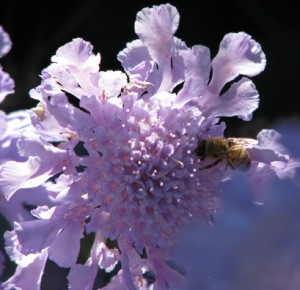 Obviously Fruitless Fall made a big impact on me. Shook me up; Jane too. The funny thing is, at the very same time that it was scaring the pants off me (a world short on pollinators is a scary, scary concept), it was filling me with wonder and delight. I know that sounds impossible. It’s the way Rowan looks so closely, with humor, warmth, and affection, at this ordinary (extraordinary!) creature, the honeybee. It reminded me of the John Stilgoe book I kept raving about last year, Outside Lies Magic. Remember that one? What Stilgoe did for me with power lines and telephone poles, Rowan Jacobsen did for me with bees and honey and even figs. The early chapters describing life in a beehive and the life cycle of the bee were so engaging that I read them aloud to 8-year-old Beanie, who was captivated. Jane (almost 14) has read the book at least three times now. She begged me to order Rowan’s book on chocolate—along with our very own copy of Fruitless Fall. Which is a good thing, because I find myself wanting to thrust the book at everyone I talk to. It’s that kind of book.
Obviously Fruitless Fall made a big impact on me. Shook me up; Jane too. The funny thing is, at the very same time that it was scaring the pants off me (a world short on pollinators is a scary, scary concept), it was filling me with wonder and delight. I know that sounds impossible. It’s the way Rowan looks so closely, with humor, warmth, and affection, at this ordinary (extraordinary!) creature, the honeybee. It reminded me of the John Stilgoe book I kept raving about last year, Outside Lies Magic. Remember that one? What Stilgoe did for me with power lines and telephone poles, Rowan Jacobsen did for me with bees and honey and even figs. The early chapters describing life in a beehive and the life cycle of the bee were so engaging that I read them aloud to 8-year-old Beanie, who was captivated. Jane (almost 14) has read the book at least three times now. She begged me to order Rowan’s book on chocolate—along with our very own copy of Fruitless Fall. Which is a good thing, because I find myself wanting to thrust the book at everyone I talk to. It’s that kind of book.
Remember this coy miss?
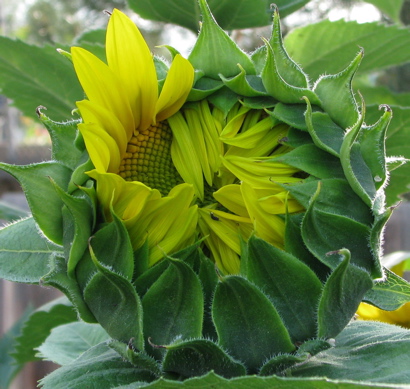
She decided to come out to play.
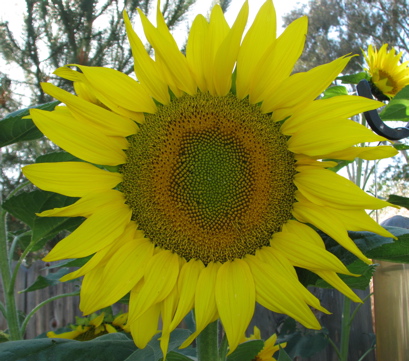
I have something very special for you today. Stephanie Spinner, author of such splendid books as Quiver and Quicksilver, not to mention the hilarious Aliens for Breakfast trilogy, graciously agreed to an interview here at Bonny Glen. Years ago, when I was fresh out of grad school, Stephanie gave me my first job in publishing as her editorial assistant at Random House and Knopf (two imprints, same office). You couldn’t ask for a better introduction to children’s book publishing: Stephanie worked on everything from picture books to beginning readers to chapter books (a genre she pioneered) to middle grade and young adult novels, and as her assistant I got to work with some of the best writers and illustrators in the business, including Gloria Whelan and George Booth. Looking back, I find it hard to believe I only worked for Stephanie for two years: I learned so much from her about writing and editing and story. I was lucky to get that tutelage when I did, because not long afterward she left the editor’s desk to write children’s books and YA fulltime. Her books shine with her elegant prose, her wry sense of humor, and her keen sensitivity for what makes people tick.
But enough of my gushing. On to the interview!
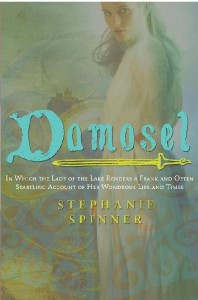 Stephanie, thanks so much for visiting Bonny Glen! Your latest novel, Damosel, is the story of the Lady of the Lake, a figure from Arthurian legend. When I think of her, I see that wonderfully eerie image of the hand rising from the lake grasping the sword in the film Excalibur. What inspired you to write from her point of view?
Stephanie, thanks so much for visiting Bonny Glen! Your latest novel, Damosel, is the story of the Lady of the Lake, a figure from Arthurian legend. When I think of her, I see that wonderfully eerie image of the hand rising from the lake grasping the sword in the film Excalibur. What inspired you to write from her point of view?
Stephanie: I’ve loved the Arthurian stories since I was a kid. And the image you mention, the hand rising out of the lake, intrigued me on sight. When I reread the tales as an adult, I was a drawn to the intricate relationships of the main characters—Arthur/Guinevere/Lancelot, Merlin/Lady of the Lake, Arthur/Mordred—rather than the battles and derring-do. Of all, the Lady was most mysterious, because she first appears as a helping spirit, making Excalibur and giving it to Arthur at Merlin’s behest, but then behaves very badly, inasmuch as she seduces and betrays Merlin. Then she more or less takes Merlin’s place as Arthur’s protector. These baffling reversals are unique, at least in Malory’s LE MORTE D’ARTHUR, my principal source. So I wondered: how could a character start off as good, turn bad, and then go back to being good, without any explanation? What if she were a well-meaning spirit who didn’t always measure up? What if she never harmed Merlin, but had a scheming cousin who did? What if she fell in love and neglected her sworn duty to Arthur? (Speaking of love, how about the fact that she was a spirit who married a human—after saving him from dying of heartbreak, no less?!) Finally, I realized that she played a part in Arthur’s story from the beginning all the way to the end—witnessing virtually the entire history of Camelot. That appealed to me a lot.
Let’s talk about research. You actually went to England and visited some of the sites associated with the Arthurian legend, didn’t you? I’m totally jealous—I wrote four books set in Scotland and have never set foot in the country. Where did you go? How did your travels affect the shape of the book?
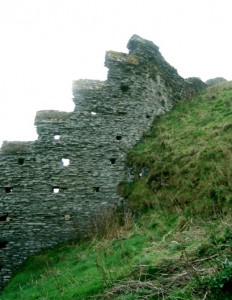 I’d wanted to make the trip for a long time, but knew I could never drive in England—driving is hard enough for me here, and the thought of trying to drive on the left is enough to make my throat close up. But after I’d begun writing, an English friend offered to drive me around to the “Arthurian” sites, and off we went. We visited the obvious places, like Stonehenge, and Tintagel Castle, Arthur’s supposed birthplace, and Camlann, where Arthur and Mordred fought. We also went to the ruins of a Roman military encampment in Wales, and the two lakes in Cornwall where the Lady was thought to dwell. The first was set on a heath and pretty featureless, though apparently Daphne du Maurier liked it enough to set REBECCA there. The second, called Looe Pool, was wonderful—a big, beautiful lake right next to the ocean. So I made that the Lady’s home.
I’d wanted to make the trip for a long time, but knew I could never drive in England—driving is hard enough for me here, and the thought of trying to drive on the left is enough to make my throat close up. But after I’d begun writing, an English friend offered to drive me around to the “Arthurian” sites, and off we went. We visited the obvious places, like Stonehenge, and Tintagel Castle, Arthur’s supposed birthplace, and Camlann, where Arthur and Mordred fought. We also went to the ruins of a Roman military encampment in Wales, and the two lakes in Cornwall where the Lady was thought to dwell. The first was set on a heath and pretty featureless, though apparently Daphne du Maurier liked it enough to set REBECCA there. The second, called Looe Pool, was wonderful—a big, beautiful lake right next to the ocean. So I made that the Lady’s home.

Of course I did other research, too. I read a great deal about the Roman occupation of Britain, early Christianity and convent life, sword making, little people, castles, Hadrian’s wall, farming, diet, and apparel. I looked at lots of maps. My favorites were the early ones with only Latin names (like Londinium, and Aquae Sulis).
Of all the Arthur stories I’ve read, I’ve never had one hit me so powerfully on the matter of Merlin’s imprisonment. It was really painful to see him walk into the trap and know that his imprisonment was permanent. What was it like to write a character so many other authors and storytellers have tackled? Besides Damosel, who were your favorite characters to write?
If it’s any consolation, I felt bad for Merlin, too, and I always have! But changing his fate was out of the question, so instead, I tried to make it clear why Nimue couldn’t resist doing what she did. There have always been beautiful, ambitious young women who are drawn to powerful older men; what makes Merlin’s story so painful is that he truly deserved better.
As for the question of familiarity, I grappled with that very early on, before I even started a file. I knew there were 11,000 other books about Arthur and Merlin, some of them works of genius. I also knew that if I thought about them while I was writing DAMOSEL, I’d never get past page one. So, once I’d decided to go ahead and write DAMOSEL, I tried to stay focused on the work at hand.
I like most of the characters in the book, even the little donkey! Twixt was definitely a favorite—for some reason writing in his voice could be surprisingly easy. I was very fond of Sir Tor, also. And I will confess to a fondness for Metite, the Lowly Gnome.
How do you think having been an editor, helping so many writers hone and polish their work, affects your own writing process?
I suppose it’s given me some confidence, but you’d never know it from my average speed, which is hideously slow. (The words “agonize” and “torturous” come to mind). I have been known to celebrate after completing a difficult sentence.
I always love to hear how other writers work. Do you revise as you go and therefore write very slowly? Or do you pound out the first draft quickly and then go back and revise? Where do you prefer to write? Do you have a routine? I eat gummy bears incessantly while working. How about you? Coffee, tea, chocolate?
Yes, I revise as I go, and then I go back and revise some more. I usually write in the morning, first polishing the previous day’s work, then moving (creeping) forward a little. Sometimes, after breaking for the afternoon, I’ll put in a few more hours at night.
My office is a bright room with a big white desk that should be a lot neater than it is; however, the photos, maps, and reference books seem to have a will of their own, and they’re taking over. I work in my bathrobe or the equivalent of pajamas, with as few distractions as possible—no music, food, or drink—though I do allow my dogs to sit on my lap if they insist.
If I recall correctly, you spent quite a bit of time in India at one point. Are there any retellings of Indian legend in your future?
I won’t rule it out, but animals, not mythology, seem to be on my mind lately. My last four books have been about a cat, a dog, a pony, and a parrot, and I have no idea what’s coming next.
Well, I for one can’t wait to see! (Jane is shouting “Me too!” over my shoulder. Big big fan, she is.)
The photos above were taken by Stephanie on her trip to England. The top one is Tintagel Castle; the second one is Looe Pool, home of Damosel. Here are a few more of her pictures: Tintagel Tower, the ocean at Looe Pool, and Stonehenge. I’m swooning.

What Scott got me for Mother’s Day:
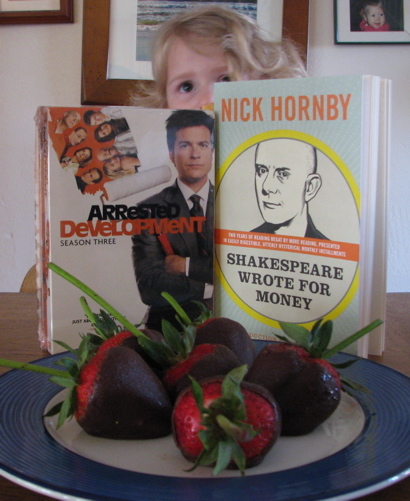
Does this guy know me well or what?
• Watched a NOVA special on bees, and watched bees outside on our sunflowers and scabiosa. I am so happy to see them buzzing around, filling those nifty leg pouches with golden pollen. Rilla stands beside me, peering so closely. Rose prefers to stay a safe distance away.
• Played lots of Harvest Moon. Such a relaxing game, I find. Planting crops, befriending forest animals, fishing. As virtual lives go, this one is quite appealing.
• Played, with lots of whooping and hollering, several exciting games of Mario Kart with my husband as the children cheered us on. We’re like a Wii commercial.
* Watched the Benjamin Button movie, which I loved, and which had almost nothing in common with the Fitzgerald short story except of course for the central conceit.
• Watched Adam’s American Idol performance three times. Fast forwarded through Danny Gokey’s, so now you know where I stand.
• Watched LOST with my heart in my throat, as I do every week.
• Watched Castle with a big silly grin on my face the whole time, as I do every week.
• Watched House through my fingers, because MOST HORRIFYING ILLNESS EVER, SKIN COMING OFF!!!
• Found an Asian grocery store that sells Taiwanese sun cakes. We were so excited. “City famous for sun cakes” was one of the clues for Jane’s Journey North Mystery Class, which (I can reveal, now that the project is over) was Taichung, Taiwan. We went to Ranch 99 hoping to find something like sun cakes to bring to end-of-project party and were dazzled and delighted by the array of freshbaked cakes in the store’s bakery counter. It was like walking into a Dunkin Donuts: so many varieties! I asked for two dozen and the clerk’s eyes got big. She asked me when I needed them. “Now,” I said, and her eyebrows went higher. “Two thousand?” she asked, obviously thinking I was crazy. “No, two dozen!” I clarified. “Twenty-four cakes!” We shared a laugh over it. She packed us an assortment including mung bean, red bean, taro, green tea, lotus, and wax gourd. The green tea filling tasted just like, um, green tea. Rilla tried a mung bean one and I’m afraid it came right back up. The taro seemed to be the favorite at the party, but “favorite” is a relative term. I think we probably came home with about 18 of the 24 cakes. The “frog cakes” from the family who had an Australian city were much more popular. Sponge cake with green sugar icing: yum.
Books I’ve seen being read this week:
Jane—
Catherine Called Birdy
Fruitless Fall (again, parts)
Chocolate Unwrapped (by the author of Fruitless Fall)
a book on Louis Braille
Babe the Very Important Pig
Either Galen something something Medicine or Archimedes something something Science, I saw from across the room and can’t remember which it was. But you know the books I mean, right? If you are homeschooling you do because they’re in every catalog everywhere. Very engaging books, even if I’m muddy on the titles right now.
Rose—
the Borrowers books
Stolen by Vivian Vande Velde (third time—guess she likes it!)
All-of-a-Kind Family (warms my heart just to type it)
Beanie—
The Princess and the Goblin
(drawing a complete blank on what else I saw her with)
Rilla—
has discovered Bob Books. “Go, Bus!” she ‘reads’ on the cover of one of them, with authority, to anyone in her path. She is also delighting in pointing to all the Sam-I-Ams in Green Eggs and Ham.
Me—
Still reading Gilead
Also George and Sam by Charlotte Moore, which I’m finding hard to put down. Fascinating account by the mother of two boys with autism and one without.
Also a whole bunch of blogs about beekeeping. Talk about fascinating!
Also the first pages of The Guernsey Literary and Potato Peel Pie Society, because it came in from the library and I couldn’t resist a peek. It looks like great fun. Another Semicolon recommendation, I think? Sherry, am I right?
I know I should clean up the formatting up there, put in italics, and such, but I just don’t feel like it. Got a baby sleeping on my lap and his sweet enormous head is cutting off the circulation in my right arm.